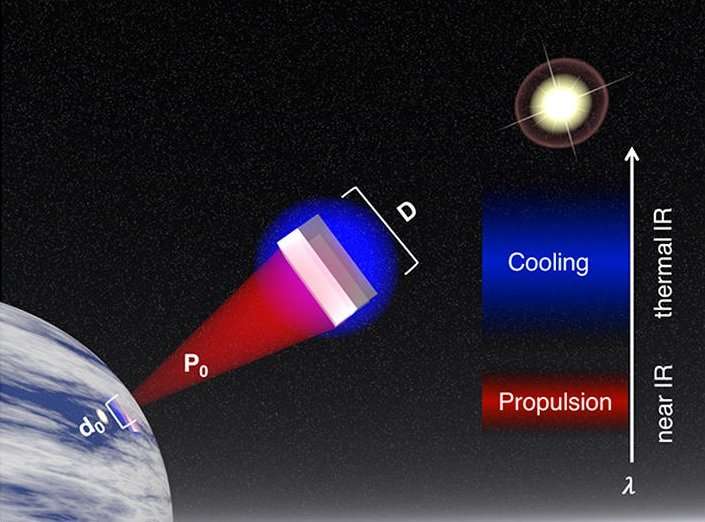September 6, 2018 feature
Nanophotonic light sails may travel at relativistic speeds

One day in the not-so-distant future, light sails may hurtle through space at speeds of around 20% of the speed of light (or 60,000 km/sec), propelled not by fuel but rather by the radiation pressure from high-power lasers on Earth. Traveling at these relativistic speeds, laser-powered light sails could reach our nearest neighboring star (other than the Sun), Alpha Centauri, or the nearest known potentially habitable planet, Proxima Centauri b, in about 20 years. Both objects are a little more than four light-years away.
Designing light sails is a major engineering challenge, however, requiring conflicting features that sound nearly impossible: an ideal light sail should be several meters wide and mechanically robust enough to withstand intense radiation pressure, yet be merely 100 nanometers or so thick and weigh just a few grams.
Further requirements arise from the mechanism by which light sails work. According to Maxwell's equations, light has momentum and as a result can exert pressure on objects. However, light sails are not simply pushed by radiation pressure like a sailboat is pushed by the wind. Instead, the push results from the light sail reflecting the radiation. As a result, an optimal sail should reflect the majority of the radiation in the laser beam's near-infrared spectrum, while simultaneously emitting radiation in the mid-infrared range for efficient radiative cooling.
Nanophotonic sails
In a new study published in Nano Letters, researchers Ognjen Ilic, Cora Went, and Harry Atwater at the California Institute of Technology, Pasadena, have shown that nanophotonic structures may have the potential to meet the stringent material requirements for light sails capable of traveling at relativistic speeds.
Previous light sail designs have used materials such as ultrathin aluminum, various polymers, and carbon fiber. Unlike these materials, nanophotonic structures have the ability to manipulate light at subwavelength scales, giving them an advantage in addressing the simultaneous requirements of efficient propulsion (reflection) and thermal management (emission). As an example, the researchers showed that a two-layer stack of silicon and silica shows promise due to the combined properties of both materials. Whereas silicon has a large refractive index—which corresponds to efficient propulsion—but a poor cooling ability, silica has good radiative cooling properties but a smaller refractive index.
In their paper, the researchers also proposed a new figure of merit that measures the trade-off between achieving a low sail mass and a high reflectivity. In the future, this concept will help to minimize constraints on the laser power and the size of the laser array.
Background on light sails
Although conceptualized for nearly a century, only in the past few decades has technology caught up to scientists' early visions of propelling a spacecraft with the pressure of light. Inspired by the way that the Sun's radiation pushes a comet's tail in the opposite direction, the earliest concepts were of solar sails that use the radiation pressure from sunlight rather than from lasers.
The first solar sail was launched in 2010 by the Japan Aerospace Exploration Agency (JAXA) and successfully reached the orbit of Venus in six months, powered only by the radiation pressure of sunlight. Now researchers are working on designing solar sails capable of greater accelerations that are competitive with rocket acceleration, offering the possibility of launching spacecraft without the billion-dollar cost of conventional propellants.
Although solar sails may achieve rocket-like speeds, sunlight radiation is relatively weak compared to a high-power laser array. As a result, a laser array offers the potential for much faster propulsion, up to relativistic speeds—but more work is needed before such laser-powered sails are demonstrated.
More information: Ognjen Ilic et al. "Nanophotonic Heterostructures for Efficient Propulsion and Radiative Cooling of Relativistic Light Sails." Nano Letters. DOI: 10.1021/acs.nanolett.8b02035
Journal information: Nano Letters
© 2018 Phys.org





















